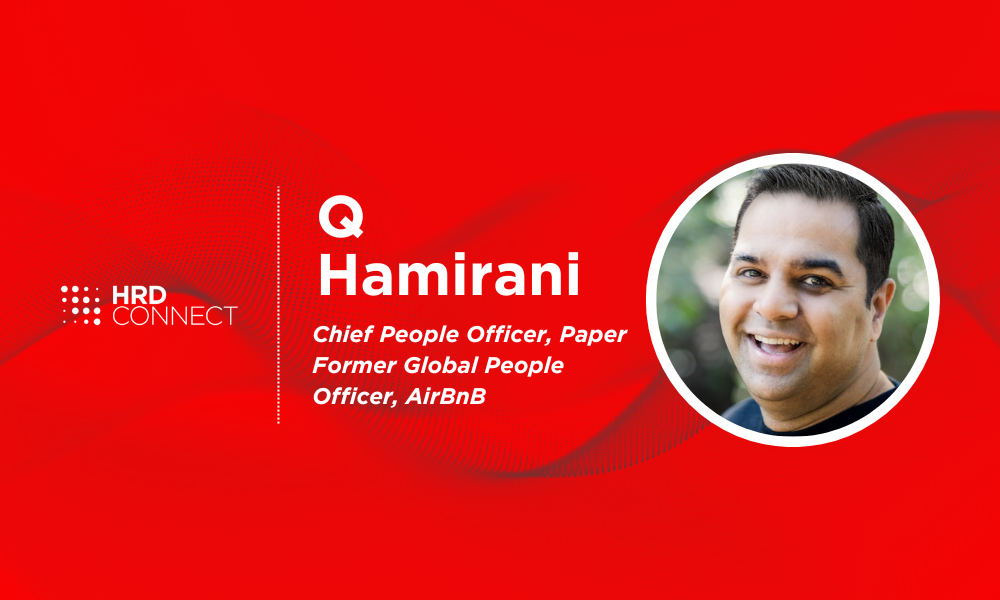Q Hamirani: Scaling corporate nomadism with a new employee value proposition
- 6 Min Read
Q Hamirani navigates a new era for corporate nomadism, from risk mitigation to developing a new employee value proposition.
- Author: HRD Connect
- Date published: Jun 8, 2023
- Categories

Nomadism is nothing new. Before the pandemic, travel was either business sponsored or a personal vacation. It was far easier to manage restrictions with work authorizations. Now, the lines are blurred, creating a new model of work that has significant implications for organizational risk and the employee value proposition: ‘Corporate Nomadism.’
Q Hamirani, Chief People Officer at Paper, and former Global People Leader at Airbnb coined ‘corporate nomadism’ to describe this new model for work and travel.
In this exclusive HRD Q&A, he debunks some common misconceptions, reveals why the complex reality of ‘corporate nomadism’ demands attention from HR leaders, and shares how organizations can scale this model in a new era of work.
1. How has ‘corporate nomadism’ evolved and why should organizations review their approach?
Q Hamirani: In the past two to three years, corporate nomadism has expanded. The lines are now a lot more blurred between traveling and working. This poses a new reality with more extensive restrictions and limitations. If I wanted to take a trip to London on my own dime and do my work from there, I cannot do so as a US Citizen, because it’s not business sponsored.
Nor is it permitted on a US tourist visa. Only about 10 to 15% of countries in the world have issued remote work or digital nomad visas. Traveling to London would not pose a risk just to me, but to the organization. Companies must follow regulations that have not yet caught up to the times. In contrast, I could travel to Greece or Croatia since they offer remote work visas for purchase.
2. What are organizations getting wrong about nomadism?
Q Hamirani: There are a couple of myths couple about nomadism. Firstly, corporate nomads are just young people in their 20s and early 30s. One of the world’s leading travel industry research authorities found that nearly three in five nomads today are over 35 years old.
Secondly, nomads must be early-career, self-employed freelancers. Again, the research shows that nearly four in five have a full-time employer and that more than half earn $100,000 or more per year. This is why the legal complexities are so important. Nomads are, often, senior, and full-time employees.
3. What complexities are there in implementing corporate nomadism at scale, and how can organizations overcome them?
Q Hamirani: Work authorization is a critical dimension of corporate nomadism. If you don’t have work authorization, you can’t work through the rest. It’s quite literally the entry point. But there are several other layers of complexities that an organization must work through to let an employee live and work anywhere.
What are the implications on their payroll or their (equity) taxes? What are the implications for data privacy? If I’m a customer service rep and I’m traveling around the world, the customer data I access in different parts of the world have different implications for privacy regulations.
The organization must think through payroll, tax, privacy, co-employment, and employment risk standpoints, in addition to considering the productivity and people management side of it. What are the time zones for collaboration? How will we continue to deliver work as an organization from a people-centric standpoint?
4. Why is it so important for organizations to assess their level of risk tolerance?
Q Hamirani: When I was at Airbnb, I set up my team to evaluate the complexities to let someone work and travel from multiple geographies. We also partnered with our policy teams to drive these regulations and open the doors from a work authorization standpoint. Much smaller organizations may choose to turn a blind eye to employee travel and be non-compliant, but if you’re a public company in the spotlight, your risk tolerance means you must evaluate the authorization complexities.
Evaluate your level of risk tolerance. Some organizations might permit employees to travel up to 30 days a year in as many countries as they like. At Airbnb, our policy was up to 90 days, per country, each year. You could be in a new country in each quarter and never back home. The risk involved in this case is far higher.
Consider, based on your maturity, phase, and size, how much risk tolerance you can take. But also consider where you are in your hybrid journey, and what your employees may want from this sort of program.
5. Do you have any other recommendations for making corporate nomadism work at scale?
Q Hamirani: Firstly, lean into the needs of your employees. Understand what they want and base your programs on this. At Airbnb, we heard loud and clear that our employees wanted to travel. As a travel company, we set about building something that was right for them. But keep on checking back. After a year, although we’d invested a lot in organizational tax implications, we learned that employees were struggling with the tax implications for themselves. So, through a third party, we gave them the support they needed.
Secondly, re-evaluate your entire employee value proposition (EVP). If you are going to support this culture and lifestyle of nomadism, your EVP completely changes. Look at it end-to-end. What are your learning programs? Your benefit programs? Your compensation philosophy? How do these all tie to performance management? Peel back all the layers of the onion.
Thirdly, determine what works best for you. Knowledge workers that do not need to be tied to the office will want flexibility, and if they don’t get it, they will go and find it. But I don’t think we have to believe that everyone is going to work remotely for this trend to continue.
6. Can you expand on how to rebuild the employee value proposition for corporate nomadism through benefits and compensation?
Q Hamirani: Consider the tangible benefits such as healthcare programs. What sort of coverage does an employee have when they’re abroad? There are plenty of third-party companies who can help offer this. But also, look at your overall compensation strategy. At Airbnb, we ended up taking out location-based pay within a country. This was quite radical for a big tech firm to do, especially in the US where different regions typically have different pay scales. There are also learning programs. We started giving an education allowance because we realized people might want to learn in different ways.
Look at it from the lens of empowering and trusting your employees to do what’s best for them. This helps them to be more productive and engaged. Airbnb’s engagement scores in a survey at the end of 2022 were at the highest they had been since we started measuring them in 2015.
You don’t just roll out a program and say, ‘We’ll support you in getting there in terms of legality.’ The employer is legally covered, but you can’t stop there. You must make it a valuable proposition for the employee from end to end. And consistently reevaluate because the world is always changing. There are new issues with personal safety and data privacy arising all the time.










